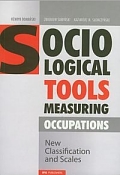|

SOCIOLOGICAL TOOLS MEASURING OCCUPATIONS NEW CLASSIFICATION AND SCALES
DOMAŃSKI H. SAWIŃSKI Z. wydawnictwo: IFIS PAN, 2009, wydanie I cena netto: 57.75 Twoja cena 54,86 zł + 5% vat - dodaj do koszyka Sociological tools measuring occupations
New classification and scales
This book deals with the measurement of social class, social standing, social status -
generally speaking - of social position, considered as placement in the social
stratification system. Social scientists ae divided into those who favor categorical
approaches to socio-economic calssification and those who prefer continous measures, which
assume that differences between elementary units can be captured in one dimension that is
represented by a single parameter.
We propose here a harmonized socio-occupational classification, referred to as Social
Classification of Occupations (SCO), which may be suitable for analyzing sociologically
derived class categories in East European countries.
Table of contents
List of Tables and Figures
Preface and Acknowledgements
Introduction
Chapter 1: Occupation as an Indication of Social Position
1.1. Classifications of occupations
1.2. Analytical uses of the occupational classifications
1.3. Occupational scales
1.4. Limitations and unsolved problems
Chapter 2: Studies on Occupational Classifications in
2.1. Systematic classifications of occupations in
2.2. Criteria used in social classifications of occupations
2.3. Social Classification of Occupations
2.4. Difficulties in using the Social Classification of Occupations
2.5. Work on modifying the Social Classification of Occupations SCO-1978
2.6. Work on adapting the International Standard Classification of Occupations (ISCO)
2.7. Polish Sociological Classification of Occupations PSCO-94
2.8. Conclusion
Chapter 3: Social Classification of Occupations in the
Context of Respondents’ Answers: Based on the Coding of Research Results
3.1. Analytical goals, methodology, and data sources
3.2. Analysis of the most frequently used coding categories
3.3. Cohesion analysis of major occupational groups
3.4. Conclusion
Chapter 4: Social Classification of Occupations–2009
4.1. Modification criteria
4.2. New principles of assigning occupations to Group 0, “Senior Officials and
Managers”
4.2.1 New division of positions in public administration
4.2.2 Top officials of political parties and special-interest organizations
4.2.3 Top managers of large enterprises and other institutions
4.2.4 Middle managerial positions
4.2.5 Incorporating lower-level managerial positions into Group 0
4.2.6 Incorporating managerial positions in trade and services into Group 0
4.3. Group 1, “Specialists”
4.3.1 Sociological interpretation of the composition of Group 1, “Specialists”
4.3.2 Occupations and specialties involving marketing and management of human resources
4.4. Group 2, “Technicians and specialized office workers”
4.5. Group 3, “Other middle-level non-manual workers”
4.6. Group 4, “Sales and service workers”
4.7. Group 5, “Skilled manual workers”
4.7.1 Subgroup of foremen
4.7.2 Internal differentiation in the largest basic categories of manual workers’
occupations
4.7.3 Reducing the number of basic categories in Group 5
4.8. Group 6, “Semi-skilled and unskilled manual workers”
4.9. Group 7, “Farmers”
4.10.Group 8, “Owners of production and service firms”
4.11.Summary
Chapter 5: Occupational Scales According to Skill
Requirements, Complexity of Work, Material Remuneration, and Prestige
5.1. The scale of skill requirements
5.2. The scale of the complexity of work
5.3. The scale of material remuneration
5.4. The scale of occupational prestige
5.5. Conclusion
Appendix 5.1 Scales of Skill Requirements and Complexity of Work
Appendix 5.2 1979 Scale of Socio-economic Status, 2009 Scale of Material
Remuneration, 1979 Scale of Occupational Prestige, and 2009 Scale of Occupational Prestige
Chapter 6: Computer-Aided Coding and Scaling Occupations
6.1. Rules for coding occupations according to SCO-2009
6.2. Structure of the SCO-2009 file in the computer format
6.2.1 Category declarations
6.2.2 Rules for distinguishing key words
6.2.3 Category order
6.2.4 Classification header
6.2.5 Residual categories
6.2.6 Supplementing the classification with additional categories
6.3. Aiding the preparation of a new classification with the sco2009index application
program
6.3.1 Working with a classification file
6.3.2 Starting the sco2009index application program
6.3.3 Displaying key words
6.3.4 Analysis of the context in which a given word appears
6.3.5 Distinguishing key words
6.3.6 Revoking key-word status of previously distinguished key words
6.3.7 Navigation between fields
6.3.8 Ending work with the application program
6.4. Content and format of data required for coding occupations
6.4.1 Content of the data set concerning the coded occupation
6.4.2 Presentation of data concerning occupation during the process of coding
6.4.3 Preparation of parameters controlling the application program
6.4.3.1 Command syntax
6.4.3.2 Declaration of the record identifier
6.4.3.3 Declarations of occupations coded
6.4.3.3.1 Command of initialization for the coded occupation
6.4.3.3.2 Filter command
6.4.3.3.3 Group of commands defining available information about the coded occupations
6.4.3.4 Commands generating occupational scales
6.4.3.5 Creating a division into 14 socio-occupational groups
6.4.4 Output-file format
6.4.5 Rules for writing occupational codes in the updated working file
6.5. The coding process
6.5.1 Start of the application program and checking for correctness of parameters
6.5.2 Coding an occupation
6.5.3 Navigation in the file of coded occupations
6.5.4 Documentation of the coding process: Notepad and Report
6.6. Scope of utilization of the sco2009coder application program and users’ rights 23
Chapter 7: Validity of the Social Classification of
Occupations–2009
7.1. Schemes for aggregating occupations
7.2. Division into 14 socio-occupational groups
7.3. Delineation of borderlines between groups
7.4. Higher-level aggregation schemes
7.5. SCO application to marketing and public opinion research – ESOMAR Social Grade
7.6 Summary
Appendix 7.1 Input file for the Correspondence Analysis
Appendix 7.2 Input file: Recode of the SCO-2009 elementary codes into 14 and 6 class
categories
Appendix 7.3 Input file: Recode of the SCO-2009 elementary codes into ESOMAR Social Grade
scale
Appendix: Social Classification of Occupations–2009
References
Index
332 pages, Paperback
Księgarnia nie działa. Nie odpowiadamy na pytania i nie realizujemy zamówien. Do odwolania !.
|


